|
|
|
| My Favourite Planet > English > Europe > Greece > Thrace |
| Thrace, Greece |
A brief history of Thrace |
|
 |
page 2 |
 |
|
| |

A stork family in their nest in the centre of Soufli, Thrace. |
| |
Following the Greek government's reforms of the country's administrative areas in 1987 and 2010, the small, remote region of Thrace, in the northeast of the country, was absorbed into the region of East Macedonia and Thrace, part of the large semi-autonomous region of Macedonia.
In a peculiar way this modern administrative legislation as regards Thrace is a latter-day continuation of policies, albeit in a more peaceful and orderly way, which began in antiquity when Greek and Macedonian expansion and colonization pushed back the areas occupied by tribal peoples collectively known as Thracians (see, for example The History of ancient Stageira).
The modern Greek part of Thrace, also referred to as Western Thrace, is a tiny remnant of ancient Thracian territory which stretched from north of Thessaly as far as the borders of modern Albania, eastwards along the coasts of the Northern Aegean and Marmara seas to the Bosphorus at Byzantium (later Constantinople, today Istanbul), and through the mountains and along the Black Sea coast northwards to the River Danube in what is now Bulgaria.
The Thracians had their own distinct language, culture and religion and produced fascinating art, crafts and coinage. The cult of the Cabeiri, ancient "Great Gods", appears to have its roots in prehistoric Thrace and was an important influence on Greek religion, particularly in cities such as Thebes, until worship of the Olympian gods became predominant.
The ancient Thracian cult mysteries retained their allure into Roman times; the cult centre at Samothraki drew pilgrims of all classes from slaves to kings, queens and emperors.
Other important myths now associated with Greek culture, such as the story of the bard Orpheus (Ὀρφέως) and aspects of the cult of Dionysus, may also have originated in Thrace.
Macedonia and Thrace lie on important trade routes between Europe, the Black Sea and Asia and have been fought over since prehistory. It is thought that the Bronze Age wars, known as the Trojan Wars after the epic poems of Homer, were part of the long struggle for control of the Northern Aegean between the Greeks and indigenous peoples. From the second wave of colonization by the Greeks between the 8th and 6th centuries BC ever more of their cities appeared along the coast and on islands such as Samothraki and Thasos.
In some places Greek colonists drove the Thracians off their lands, while in others it appears that Greeks and Thracians achieved some sort of peaceful coexistence, perhaps from as early as the Bronze Age. |
|
 |
| |

The symbol of
East Macedonia
and Thrace |
| |
|
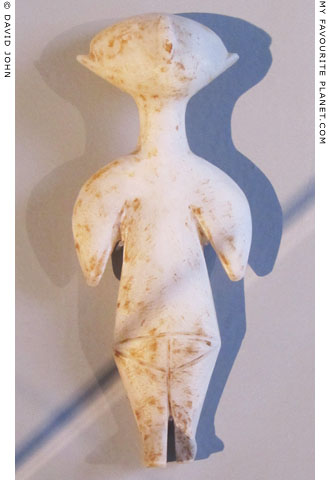
Prehistoric marble female idol from Babaköy, northwestern Turkey.
Circa 4200-3000 BC, Chalcolithic Period. Height 9.9 cm, width 3.8 cm.
Probably from an ancient grave. The figure belongs to the Kiliya type, named
after the location of the first discovery of the type in the Thracian Chersonese
(Gallipoli Peninsula). Most figures are female, thought to be fertility goddesses,
and are known as "stargazers" due to the raised position of the head.
Antikensammlung, State Museums Berlin (SMB).
Inv. No. 31457. Acquired in 1933 by Theodor Wiegand. |
| |
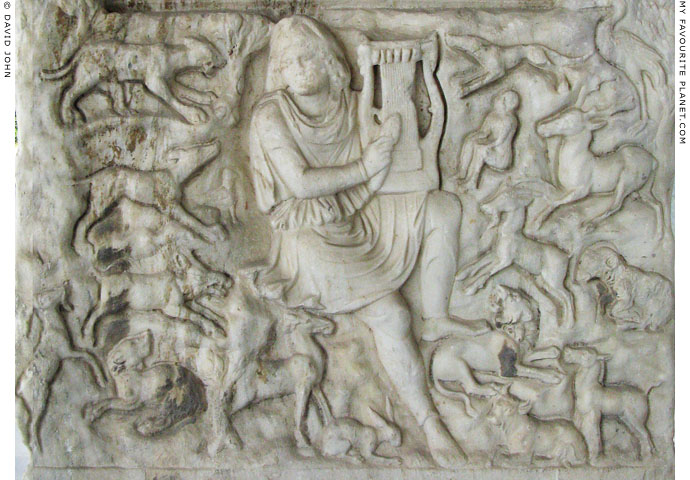
The Thracian bard Orpheus playing his lyre to wild animals,
a popular theme in ancient Greek and Roman art.
"With his songs, Orpheus, the bard of Thrace, allured the trees,
the savage animals, and even the insensate rocks, to follow him."
Ovid (43 BC – 17/18 AD), Metamorphoses, Book XI.
A relief on the side of a marble sarcophagus in the Neo Attic style
of the Roman Imperial period, made in Athens, mid 3rd century AD,
in imitation of Classical and Hellenistic sculpture. Pentelic marble.
Thessaloniki Archaeological Museum. Inv. No. 1246.
See the relief on the front of the sarcophagus in Homer part 2. |
| |
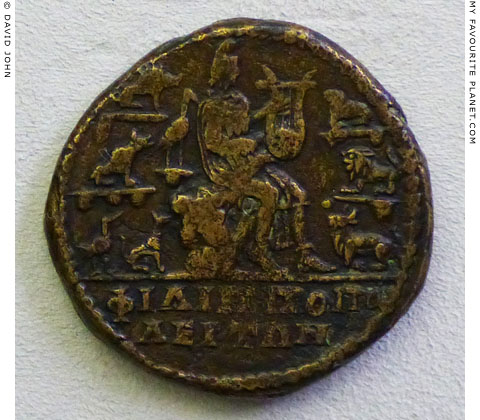
Orpheus serenading animals on the reverse side of a bronze coin from
Philippopolis, Thrace, issued by co-emperor Geta (reigned 209-211 AD).
Bode Museum, Berlin.
Displayed in the temporary exhibition of Thracian coins
"Thrakien 3.0. Münzprägung im Land des Orpheus", 16 October 2015 - 30 March 2016. |
| |
Greek expansion was temporarily checked by the Persian invasions between 514 and 497 BC, during which time Thrace was occupied by the forces of Darius I and his successor Xerxes I. After the Persians had been driven out Athens became the main power in the area as the head of an empire today known as the Delian League. Many subject cities rebelled and were aided by Sparta which waged war on the Athenians (the Peloponnesian War 431-404 BC) and eventually defeated them.
In the 4th century BC the Macedonian king Philip II, father of Alexander the Great, took advantage of the disunity of the Greek states to expand into Thrace and then take control of Greece.
During the Hellenistic period, successors of Alexander the Great, such as Lysimachus (see Pergamon photo gallery 2, page 3), claimed to be kings of Thrace. Usually they only ruled over Hellenized coastal areas while their dominions were constantly challenged by Thracian kingdoms such as that of Seuthes III.
Inevitably Thracian culture was influenced by that of the Greeks and later the all-conquering Romans who made Thrace a province of their empire in 46 AD. Very little written testimony by the Thracians themselves has survived, and most of what we know about them was written by Greek and Roman authors.
Despite the Greek, Macedonian and Roman conquests, much of what was Thracian territory along the strip of land from Halkidiki to Byzantium continued to be referred to by ancient authors and in inscriptions as Thrace.
With the arrival of Christianity and then Islam, and the continual invasions by people from other cultures, particularly Slavs and Ottoman Turks, the ancient pagan Thracian culture disappeared along with the languages of the people who lived here.
The eastern part of the Roman Empire became what is known today as the Byzantine Empire, with its capital at Constantinople (formerly Byzantium, now Istanbul) in eastern Thrace. The empire was threatened by many wars and invasions, notably by Bulgarians and crusaders.
The Ottoman Turks conquered parts of Thrace in 1354 and established their first capital in Europe at Didymoteicho in 1361 (see photo below). In 1366 they moved their capital to the Roman-founded city of Adrianople (today Edirne) before taking Constantinople in 1453. During the Ottoman period the area was settled by Albanians, Turks, Bulgarians, Roma and Sephardic Jews.
During the 19th century Thrace became an important producer of tobacco and silk, with the town of Soufli as a local centre of silk manufacture. Today Soufli has two silk museums.
The rise of Balkan nationalism in the 19th century led to the Greek War of Independence, the Balkan Wars of 1912-1913 and the First World War. The various ethnic groups which had fought together for independence from Turkey - including Albanians, Bulgarians, Greeks and Serbians - proceeded to fight amongst themselves for control of the liberated territories. This caused enormous suffering for the people of the region, particularly for ethnic groups who were minorities in the territority of another group.
After the First World War international conferences and treaties fixed borders of the Balkan states resulting in the division of the historical area of Thrace into three parts: Northern Thrace, by far the largest part, became part of Bulgaria; Western Thrace, between Xanthi and the Evros River, went to Greece; Eastern Thrace, east of the Evros to the Bosphorus, remained Turkish (today part of the Marmara Region).
The forced population exchanges between Greece and Turkey in the 1920s meant that many Greeks arrived in Thrace as refugees from Turkey. Many people who found themselves on the wrong side of the new borders chose or were pressured to emigrate, a process which continued into the late 20th century. Despite these migrations, Greek Thrace remains one of the most ethnically mixed areas in the Balkans.
Since the late 19th century there has been a gradual increase in interest in and reappraisal of the Thracian heritage, and its vestiges are being unearthed in many places around the southern Balkans, particularly in Bulgaria.
In West Thrace there are no large archaeological museums or spectacular sites, although there are some modest places of historical interest, including the ruins of the ancient walls around Didymoteicho (see a photo of the town's 15th century mosque below), the Byzantine castle at Pythio, a few small sites (see Archaeological sites near Alexandroupoli) and several Thracian tombs. Apart from the Archaeological Museum of Komotini and the silk museums in Soufli there are also small ethnological (folklore) museums in Alexandroupoli and Didymoteicho. There are also many old churches, mosques and traditionally-built houses in the region.
See also: A brief history of Alexandroupoli, Thrace |
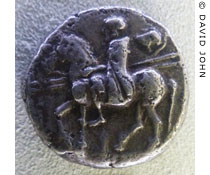
Coin of King Sparadokos,
the first Thracian dynast to
mint silver coins. 450-400 BC.
Bode Museum, Berlin. |
| |
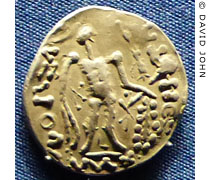
Tetradrachm coin of the
Eastern Celts. From Thrace,
2nd - 1st century BC.
Münzkabinett, Staatliche
Kunstsammlungen, Dresden. |
| |
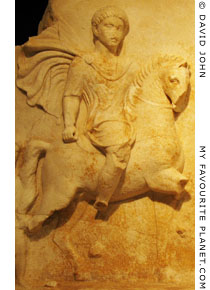
Detail of a relief showing
the mythical hero horseman
of Thrace. First century AD.
Thessaloniki Archaeological
Museum. |
| |
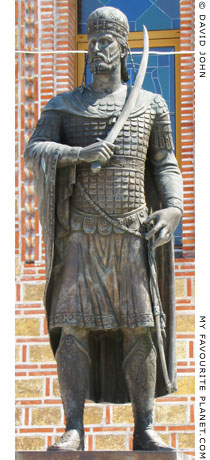
Modern statue of Constantine
XI Palaiologos (1405-1453),
the last Byzantine emperor,
in Didymoteicho, Thrace |
| |
|
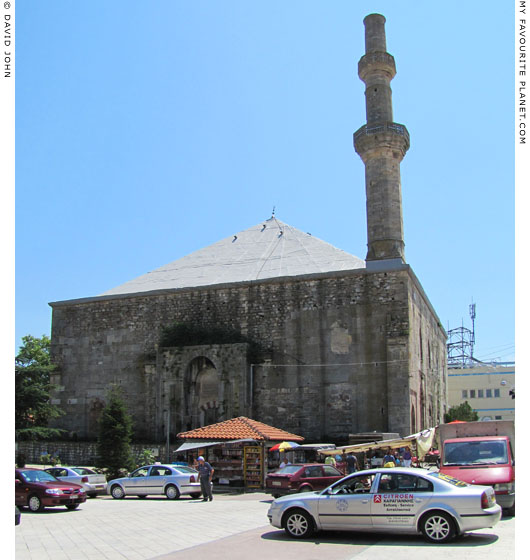
The 15th century Çelebi Sultan Mehmed Mosque (Turkish, Çelebi Sultan Mehmed Camii;
Greek, Τέμενος Μεχμέτ Α', Temenos Mechmet I), also known as the Beyazid Mosque
(Τέμενος Βαγιαζήτ, Temenos Bayazit) in the centre of Didymoteicho, Thrace.
Designed by architect Ivaz ibn Bayezid, the mosque's construction
was begun during the reign of Sultan Bayezid I (reigned 1389–1402),
and completed in 1420 under Sultan Mehmed I (reigned 1413–1421).
|
The Thracian town Didymoteicho (Διδυμότειχο) is thought to be the location of the Roman city Plotinopolis (Πλωτινούπολις or Πλωτινοπολις). Originally a Thracian then Hellenistic settlement (perhaps named Kerselenos) on the Erythropotamos river (Ερυθροπόταμος), just west of where it flows into the Hebros River (Έβρος; pronounced Evros in modern Greek), which today forms the border between Greece and Turkey. It is believed that the town was destroyed by the Romans in 204 BC, during their conquest of Macedonia and Thrace. In 45 AD Thrace was made a Roman province. Emperor Trajan (53-117 AD; reigned 98-117 AD) refounded it as a Roman city and renamed after his wife, Pompeia Plotina (empress 98-117 AD; died 121/122 AD). Plotina was a highly educated woman, who became a friend and ally of Trajan's adopted heir and successor Hadrian.
In the 6th century AD Byzantine emperor Justinian I (reigned 527-565 AD) restored fortifications on the two hills above the river, Kastro (Το Κάστρο, Castle; also known as Kale, its name in Turkish) and the lower Agia Petra (Αγία Πέτρα). The fortified hills became known as Didymoteicho (Διδυμότειχο, Twin Fortifications). From the end of the 7th century, Agia Petra, thought to be the site of Plotinopolis, was abandoned, and the city continued to develop within the walls on Kastro hill.
First conquered by the Ottoman Turks in 1359, Didymoteicho became their first capital in Europe in 1361, before they took Adrianople (today Edirne) in 1366 and then Constantinople (Istanbul) in 1453. Didymoteicho officially became a part of the modern Greek state following the Treaty of Sèvres in July 1920. In 1965 a golden bust of Emperor Septimius Severus was unearthed on Kale Hill (see Medusa part 4).
There are now few remains of the ancient city to be seen and archaeological investigations there have been few and sporadic. Most recently, discoveries made during locally-financed excavations between 2007 and 2013 included a richly decorated mosaic floor of a baths, around 130 square metres in area, from the late 2nd to early 3rd century AD. Among the many fabulous and mythological figures depicted in the mosaic are Apollo, the Muses, Eros riding a dolphin and a Nereid. |
|
|
| |
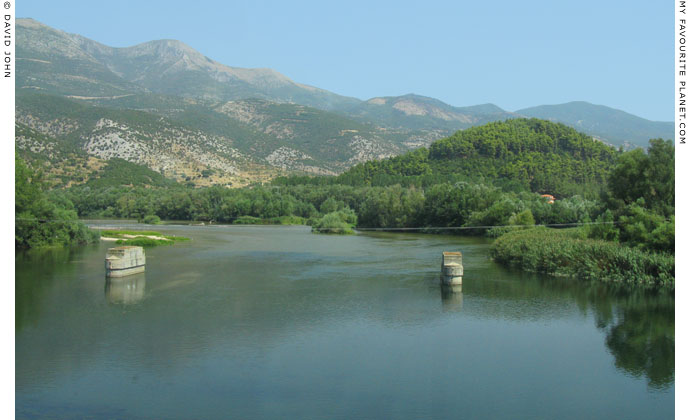
The Evros River, which forms a natural boundary between
Greece (West Thrace) and Turkey (East Thrace). |
| |
Thrace,
Greece |
Area map |
|
 |
|
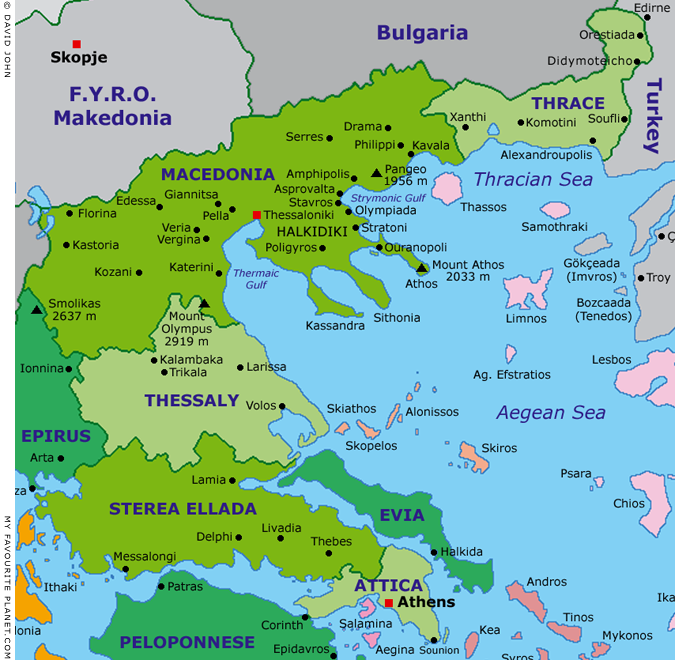
Interactive map of Macedonia, Thrace, Central Greece and the Aegean.
Colour key for Greek island groups (west-east)
| |
|
Argo-Saronic |
|
|
|
Sporades |
|
|
|
Cyclades |
|
|
|
Northern Aegean |
|
|
|
Dodecanese |
See also our interactive map of Greece. |
| |
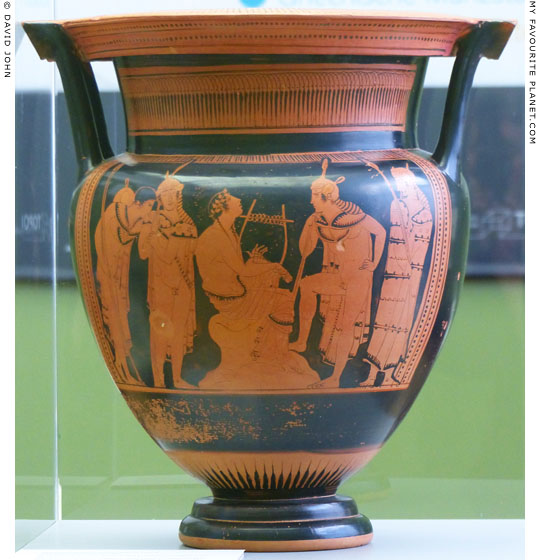
"Orpheus among the Thracians"
Vase painting of Orpheus sitting on a rock, playing his lyre and singing for four attentive Thracian
warriors who wear fox-skin caps and long, colourful, embroidered cloaks. Above Orpheus is the
Greek inscription "ΚΑΛΟΣ ΚΑΛΟΣ" (beautiful, beautiful). See drawing below. The figure to the
right of Orpheus has been identified by some scholars as the Thracian king Oiagros.
Attic red-figure column krater; name vase of the Orpheus Painter, circa 450 BC.
Discovered in Gela, southern Sicily.
Antikensammlung, State Museums Berlin (SMB). Inv. No. V. I. 3172.
Purchased for the royal collection, Berlin from M. Aldisio in 1890. Height 50.7 cm, diameter 40 cm.
Exhibited at the Bode Museum, Berlin during the temporary exhibtion of Thracian coins,
"THRAKIEN 3.0. Münzprägung im Land des Orpheus", 16 October 2015 – 30 March 2016.
|
Herodotus wrote that the Thracian Thynians and Bithynians living in Anatolia (Asia Minor) were among the peoples subjugated by the Lydian king Croesus (Histories, Book 1, chapter 28). Later the Persians conquered Croesus' empire and eventually most of Thrace was subjected by the Persian kings. The historian also described the clothing and arms of the Thracians in the army of King Xerxes that invaded Greece in 480 BC.
"The Thracians in the army wore fox-skin caps on their heads, and tunics on their bodies; over these they wore embroidered mantles; they had shoes of fawnskin on their feet and legs; they also had javelins and little shields and daggers. They took the name of Bithynians after they crossed over to Asia; before that they were called (as they themselves say) Strymonians, since they lived by the Strymon; they say that they were driven from their homes by Teucrians and Mysians. The commander of the Thracians of Asia was Bassaces son of Artabanus."
Herodotus, Histories, Book 7, chapter 75. At Perseus Digital Library. |
|
|
| |
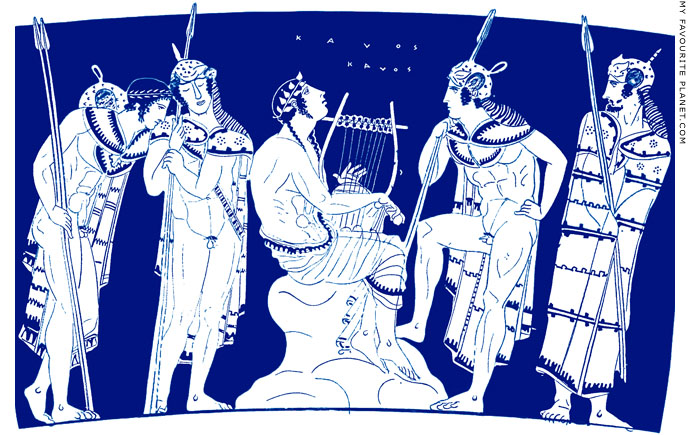
Drawing of the "Orpheus among the Thracians" vase painting.
Drawing by "Herr van Geldern". An illustration of an article on the vase:
Adolf Furtwängler, Orpheus: attische Vase aus Gela (1890), reprinted in Johannes Sieveking
and Ludwig Curtius (editors), Kleine Schriften von Adolf Furtwängler, Zweite Band,
pages 522-532, Tafel 50. C. H. Beck'sche Verlagsbuchhandlung Oskar Beck, München, 1913. |
| |
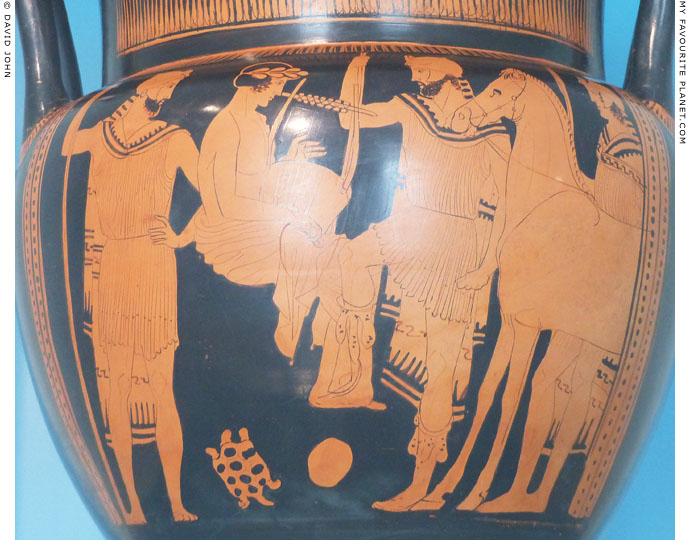
Orpheus playing among Thracians warriors, by the Painter of Naples, on another
Attic red-figure column krater, made about the same time, circa 450 BC. The
painter has omitted the rock on which Orpheus sits, but has introduced a horse,
a tortoise and even a stone which has been enchanted the bard's music.
Museum für Kunst und Gewerbe Hamburg. Inv. No. 1968.79. |
| |

Part of a marble stele with an Athenian honorary decree (a proxeny decree)
granting the title of proxenos (πρόξενος, literally "instead of a foreigner";
an honorary consul) and benefactor to Sochares, son of Chares, a citizen
of Apollonia, Pontic Thrace (Ἀπολλωνία Ποντική, Apollonia Pontiki; today
Sozopol, Bulgaria), on the Black Sea coast.
Originally from Athens, mid 4th century BC. Present dimensions:
height 76 cm, relief 36 cm, width 44 cm, thickness 7 cm.
Height of letters letters 0.7 cm.
Antonino Salinas Regional Archaeological Museum,
Palermo, Sicily. Inv. No. NI 1549. |
The marble stele was found in the area of the Ilissos river, Athens, and taken from Greece to Sicily by the London-born painter Irish painter and archaeologist Robert Fagan (1761-1816), a dubious character who acquired a collection of ancient artworks from Greece, Italy and Sicily. Due to financial and legal difficulties, he was forced to leave his ill-gotten gains in Sicily. See Athens Acropolis page 15.
Only part of the upper right side of the stele has survived. At the top is a relief in the form of a naiskos (ναΐσκος, small temple) in which are three figures. On the far right, Apollo, as personification of Apollonia, sits on the Omphalos, facing left. On the far left stands Athena, patron goddess of Athens, stands facing left. She was probably placing an honorary laurel wreath on the head of Sochares (Σοχάρες), but her right hand and the other is figure or figures further to the left are now missing. Between these to deities stands another goddess, perhaps Leto, Apollo's mother.
Below the relief is part of the inscribed text of the decree. Another fragment of the relief with the first line of the inscription has been found in Athens, and is now in the Epigraphical Museum, Athens. In. No. EM 5415.
"[προξενία Σο]χάρει Χάρητος Ἀπο[λλωνιάτηι]."
From the inscription, it is thought that Sochares was honoured for sending some kind of aid to Methone (Μεθώνη), an ally of Athens (originally a colony of Eretria, Euboea) on the the west side of the Thermaic Gulf, probably when it was beseiged and taken by Philip II of Macedon in 355/354 BC.
"Proxeny (granted) to Sochares, son of Chares, citizen of Apollonia.
Under the rule of archon Kallistratos, during the fifth prytany of the Pandionis tribe of which Pandios, son of Sokles from the demos of Oion, was the secretary, third day of the prytany. From among the proedroi Glauketes was put forward for the election [...]. Seemed to the council and the people; Aristophon proposed: praise be to Sochares, son of Chares, citizen of Apollonia [...] since proved to be keen to help the citizens and he sent to Methone [...], and let him be appointed proxenos of the Athenian people, him and his descendants as well, and let him be entitled to own a house (in Athens); the council's secretary shall transcribe (the decree) on a memorial slab [...] ten [...] at the expense of [Sochares himself?]."
Inscriptions IG II.5 70, IG II² 130 + SEG 19.49. See also SEG 24.85.
According to another reading, the name of the proxenos is Lachares (Λαχάρης) not Sochares.
See also an Athenian proxeny decree for a citizen of Croton. |
|
Photos, maps and articles: © David John,
except where otherwise specified.
All photos and articles are copyright protected.
Images and materials by other authors
have been attributed where applicable.
Please do not use these photos or articles without permission.
If you are interested in using any of the photos for your website,
project or publication, please get in contact.
Higher resolution versions are available on request.
My Favourite Planet makes great efforts to provide
comprehensive and accurate information across this website.
However, we can take no responsibility for inaccuracies or changes
made by providers of services mentioned on these pages. |
| |
 |
Visit the My Favourite Planet Group on Facebook.
Join the group, write a message or comment,
post photos and videos, start a discussion... |
|
|
| |
|
|
| |
| |
 |
| |
 |
| |
George Alvanos
rooms in
Kavala's historic Panagia District
Anthemiou 35,
Kavala, Greece
kavalarooms.gr
|
| |
 |
| |
 |
| |
 |
| |
 |
| |
Olive Garden Restaurant
Kastellorizo,
Greece
+30 22460 49 109
kastellorizo.de
|
| |
Papoutsis
Travel Agency
Kastellorizo,
Greece
+30 22460 49 286
greeklodgings.gr
|
| |
|